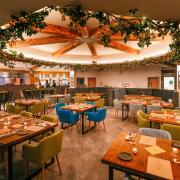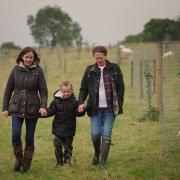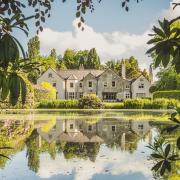Wind and rain, snow and ice, and a sun that rises at 8am and has disappeared by 4pm. All these things conspire to keep walkers off the fells during the winter.
But boots don't have to be consigned to the back of the cupboard at this time of the year; there are plenty of great walks in the valleys, beside the lakes and on the low fells.
And, with the mountains covered in snow, this can often be one of the most visually stunning times to visit the National Park. So, hunt out your hat and gloves, make yourself a flask of steaming coffee, and enjoy the Lakes... whatever the season.
Here are ten of my favourites

Hardknott Fort and Harter Fell
Harter Fell may be only 2129ft high, but the way its craggy outline towers over Eskdale, you'd be forgiven for thinking this knobbly peak reached a far greater height. On the way to the summit, the Lake District's most spectacularly located Roman remains can be visited: the substantial walls of Hardknott Fort sit high up on a grassy spur about 650ft above Eskdale with views of the Scafell range. That amazing prospect - and more besides - dominates much of the walk as you then climb to the summit of Harter Fell. Return via unfrequented country with views to the coast to complete this 4¼-mile route.

Buttermere
For an easy, 4¼-mile walk in magnificent surroundings, look no further than the circuit of Buttermere. This little lake, probably one of the most photographed in the Lake District, is ringed by spectacular mountain scenery. The steep slopes of the craggy High Stile range loom over the south-western shore, while the narrow, shapely ridge of Fleetwith Edge comes almost all the way down to the water's edge. With mostly good paths underfoot, you'll have plenty of time to enjoy the views. A short tunnel hewn through the rock at Hassness provides a moment of excitement on the return route.

Great Langdale
Dominated by the iconic Langdale Pikes and culminating in the high wall of rock thrown up by the ridge comprising Crinkle Crags and Bow Fell, Great Langdale is one of the most dramatic of Lakeland valleys. There are many ways to enjoy it without having to climb on to the high fells. A 9¾-mile route from Elterwater starts with a stroll along the low, grassy ridge of Dow Bank. It then uses good tracks and paths in the valley bottom to make its way gradually up towards the valley head. The turning point is Mickleden Beck, which has to be carefully forded.

Castlerigg Stone Circle and High Rigg
High Rigg is a lovely little lump of fell - sometimes grassy, sometimes craggy - towered over by all its neighbours. Its highest point is just 1171ft above sea level, and yet it has much to offer: hidden tarns, dark crags, springs and becks galore, knobbly summits, even a short section of narrow, heather-covered ridge - it's like the Lake District in miniature. It makes a great introduction to fell-walking. For a straightforward 8½-mile walk, approach High Rigg from the enigmatic Castlerigg Stone Circle and then return via St John's in the Vale and the open pastures of Low Rigg.

Ullswater Shore
Ullswater is the second largest lake in the National Park, curling from the eastern fells to within a stone's throw of Penrith. Its shores can be explored on several linear walks using the Ullswater 'Steamer'. Start from Howtown to follow the glorious lakeside path along the base of the fells to Patterdale and Glenridding. At first, gentle green slopes run down to the water's edge, but as you make your way south, the views become craggier and more dramatic. For an impressive finale to this 7-mile route, come away from the well-trodden lakeside path to climb juniper-clad Silver Crag.

School Knott
School Knott is truly titchy. At just 761ft, it sits above the eastern shore of Windermere. It can be climbed directly from Windermere or Bowness, but for a more pleasing approach, follow the Dales Way from Staveley and then divert from the long-distance route to climb grassy slopes to the summit. Immediately ahead of you now is the glorious northern end of the lake, with its eponymous town below. The tempting ridges of the mountains above Coniston seem to be just a stone's throw away across the water, but it is the shapely Langdale Pikes which inevitably draw the eye. From the top, drop to Windermere to catch the bus or train back to Staveley.

Latrigg
La'al Latrigg (1207ft) squats modestly at the foot of the mighty Skiddaw, overlooking Keswick. A popular destination all year round, it provides walkers with a superb perspective on Derwentwater and the high fells beyond. It can be climbed directly from the northern edge of Keswick, a walk that takes about 90 minutes one-way. Even less demanding, start from the car park at the end of Gale Road on the southern flanks of Skiddaw. At almost 1000ft above sea level, this leaves walkers with a half-hour stroll to the top. As an added bonus, there's even a bench near the summit. How easy is that?

Low Fell
There's a steep pull from Loweswater via Darling Fell to the top of Low Fell, but the rewards are well worth it. The views, particularly of Melbreak and Crummock Water, are hard to beat anywhere in the western Lakes. The panorama of high fells takes in Whiteside, Grasmoor and the High Stile range among others. A tip though: the best views are to be had, not from the 1387ft summit, but from a cairn hidden away on the southern edge of the high ground. This also makes a great picnic spot - a place to wrap up warm, make yourself comfortable and soak up all that natural splendour.

Ard Crags and Knott Rigg
You'd normally have to climb on to the high fells to find ridge-walking of this quality in the Lake District. But here, at little more than 1900ft above sea level, is a sublime crest - not too wide, not too narrow - that gives walkers a wonderful sense of soaring above the everyday world. For a relatively short walk of about 6½ miles, approach the ridge from Buttermere via the valley of Sail Beck. Ard Crags is climbed first, a punishing ascent followed by the airy walk to the slightly lower Knott Rigg. After dropping to Newlands Hause, walk the road back into the village.

Sallows
Hill-walkers often talk disparagingly of Sallows and the other hills of Kentmere Park. They're described as 'boring' and 'unexciting', but experience them on a sunny winter's day when the surrounding fells are snow-covered and the sun's still low in the sky, and there's a haunting beauty to these little lumps and bumps. Park up in Kentmere and walk the Garburn Road as far as the pass. From here, it's an easy climb to the 1693ft summit. Carry on to neighbouring Sour Howes before dropping south-east on to an old track that leads back to Kentmere. Less than six miles in total, it's a perfect length of walk for this time of year.

The book:
Vivienne Crow is an award-winning freelance writer and photographer, specialising in the outdoors. She has written more than a dozen guides to the Lake District, including Lake District: Low Level and Lake Walks and Lake District: High Level and Fell Walks (Cicerone, £9.99 each).


























